

Pearltrees launches Twitter sync and reveals its social system. [France] Paris-based Pearltrees has been catching interest around the web the last few days not least because a gaggle influential Silicon Valley bloggers have descended on Paris for Le Web, but mainly because of its interesting model for visually mapping how people collect and share information on the Web.
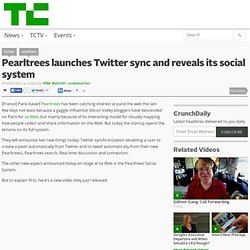
But today the startup opens the kimono on its full system. Pearltrees Visualizes How You Organize the Web. This post is part of Mashable's Spark of Genius series, which highlights a unique feature of startups.
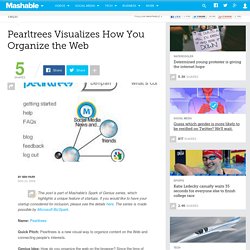
If you would like to have your startup considered for inclusion, please see the details here. The series is made possible by Microsoft BizSpark. Name: Pearltrees Quick Pitch: Pearltrees is a new visual way to organize content on the Web and connecting people's interests. Genius Idea: How do you organize the web on the browser? Signing up for Pearltrees is simple, but getting used to the interface and all of its features is not as easy. Pearltrees: Bookmarking Program for Organization Lovers. (This review is part of the Traveling Geeks tech tour of Paris.
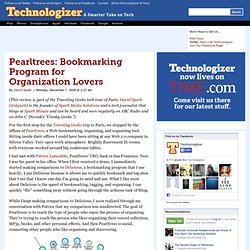
David Spark (@dspark) is the founder of Spark Media Solutions and a tech journalist that blogs at Spark Minute and can be heard and seen regularly on ABC Radio and on John C. Dvorak’s “Cranky Geeks.”) For the first stop for the Traveling Geeks trip to Paris, we stopped by the offices of Pearltrees, a Web bookmarking, organizing, and organizing tool. Sitting inside their offices I could have been sitting at any Web 2.0 company in Silicon Valley.
Very open work atmosphere. I had met with Patrice Lamonthe, Pearltrees’ CEO, back in San Francisco. While I kept making comparisons to Delicious, I soon realized through my conversation with Patrice that my comparison was misdirected. I have one harsh criticism of the product that I believe is extremely fixable. Pearltrees: A visual social bookmarking tool that has its own ta. If you’re the type of obsessive-compulsive person who needs to organize the firehose of information confronting you every day on the web, then Pearltrees might work for you.
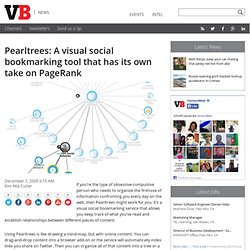
It’s a visual social bookmarking service that allows you keep track of what you’ve read and establish relationships between different pieces of content. Using Pearltrees is like drawing a mind-map, but with online content. You can drag-and-drop content into a browser add-on or the service will automatically index links you share on Twitter. Then you can organize all of that content into a tree or a web of keywords like the picture shown above. It’s like organizing bookmarks into folders and sub-folders but in a two-dimensional space. Other people can follow, link or add to the trees you’ve built, so there’s a social element to the site. Pearltree’s approach involves a pretty unique user interface, and it will probably work better for people who think visually. Q&A: Patrice Lamothe of Pearltrees on personal organisation of t. Believe me when I say you've never used a web application quite like pearltrees.
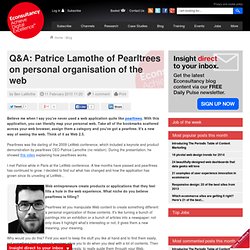
With this application, you can literally map your personal web. Take all of the bookmarks scattered across your web browser, assign them a category and you've got a pearltree. It's a new way of seeing the web. Think of it as Web 2.5. Pearltrees was the darling of the 2009 LeWeb conference, which included a keynote and product demonstration by pearltrees CEO Patrice Lamothe (no relation). PearlTrees: Social Bookmarking in Tree Form. Pearltrees is a web-based social bookmarking application with a unique visual approach.
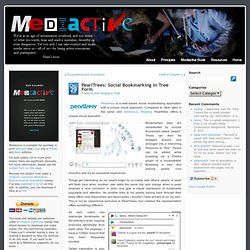
Compared to other sites in the same vein (Delicious, Xmarks), Pearltrees offers a unique visual approach. Bookmarked sites are represented by circular thumbnails called “pearls.” These can then be dragged around and arranged into a branching hierarchy or “tree.” Some media coverage of Pearltrees beta launch. Pearltrees: A Design Interface for Remapping the Web - ReadWrite. It's rare to look at a bookmarking tool and feel convinced that it's going to win a design award.
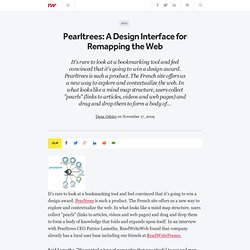
Pearltrees is such a product. The French site offers us a new way to explore and contextualize the web. In what looks like a mind map structure, users collect "pearls" (links to articles, videos and web pages) and drag and drop them to form a body of knowledge that folds and expands upon itself. In an interview with Pearltrees CEO Patrice Lamothe, ReadWriteWeb found that company already has a loyal user base including our friends at ReadWriteFrance. Said Lamothe, "We wanted a type of game play that was playful to use and map the web...and the fact that you can group and ungroup content easily means that you can re-catalogue it and keep it current. " Rather than looking at the web as a series of linear pages, this service lets us build tree graphs of connecting arguments, share them and then break them at any time. Rww. Foresight Publishing» Blog Archive » Why Pearltrees glistens lik. Early last year I was chatting to Le Laissez Faire, my go-to-guy for all things networked, about his vision for the web.
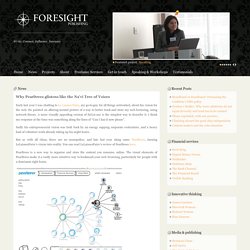
He painted an alluring mental picture of a way to better track and store my web browsing, using network theory. A more visually appealing version of del.ici.ous is the simplest way to describe it. I think my response at the time was something along the lines of “Can I haz it now please”. Sadly his entrepreneurial vision was held back by an energy sapping corporate restructure, and a heavy load of volunteer work already taking up his night hours. But as with all ideas, there are no monopolies, and late last year along came Pearltrees, turning LeLaissezFaire’s vision into reality. Pearltrees is a new way to organise and store the content you consume online. But Pearltrees goes beyond bookmarking to incorporate some interesting social elements and integration with other social media sites, including Twitter. Store and link out or embed stories on one hot topic. PearlTrees: A Novel Approach To Human Mapping Of The Internet -
Posted by Tom Foremski - November 16, 2009 Patrice Lamothe is the CEO of PearlTrees, an unique social bookmarking service that uses the visual metaphor of "pearls" with each containing a web page.
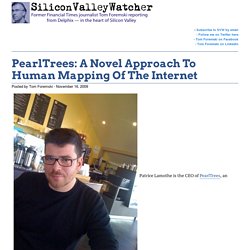
And like all visual metaphors it is best to see it rather than read a description. Meet Pearltrees: Bookmarks with a social twist. A French Web site, called Pearltrees, is developing a Web service that is trying to bring a social networking element to bookmarking - but with the connections based on content instead of people.
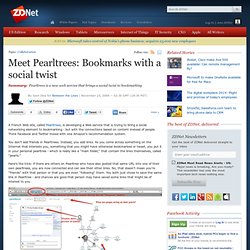
Think Facebook and Twitter mixed with one Amazon's recommendation system. You don't add friends in Pearltrees. Instead, you add links. As you come across something on the Internet that interests you, something that you might have otherwise bookmarked or tweet, you put it in your personal pearltree - which is really like a "main folder," that contain the links themselves, called "pearls. " Here's the trick: if there are others on Pearltree who have also posted that same URL into one of their own pearltrees, you are now connected and can see their other links. The service, which is free, is still in alpha mode and has limited functionality and exposure. For now, it's a bit buggy but the concept is pretty solid. Pearltrees Offers A Different View On Bookmarking.
A few weeks ago, I met Patrice Lamothe who showed me his newest product, called Pearltrees which I found had a pretty interesting and different interface. Just what is Pearltrees? According to the company’s website, it lets you organize the web in a way that you want. Once you start, you’re going to be able to discover some new things that you may not have been aware of. If you imagined there being a social bookmarking tool that followed the “Six Degrees of Kevin Bacon” methodology, then Pearltrees is probably the closest thing to it. What’s perhaps the most interesting about this type of social bookmarking is that it’s not a popularity contest like Digg or an online database like Del.icio.us. To accomplish this, Pearltrees allows you to first have Pearls and Pearltrees. As you can see in this image, the interface of Pearltrees is somewhat unique. What makes Pearltrees even more remarkable, beyond its non-conforming design, is that it focuses on the content, NOT the people you know.
Pearltrees Review. Pearltrees reviews. A new web paradigm: Pearltrees. Robert Scoble: It's not often anymore tha... Scoble's interview. Pearltrees: A Unique Way to Discover & Organize. « Zorap Creates Traveling Geeks Virtual Geek Pad for France Blogging Tour | Main | Orange Highlights at LeWeb #leweb » December 07, 2009 Pearltrees: A Unique Way to Discover & Organize on the Web Pearltrees CEO Patrice Lamothe meets us at the door of their offices on rue de charonne in a funky, artsy area of Paris that houses other early stage companies and ad agencies, not unlike San Francisco's SOMA in many ways. Coffee waiting? You betcha and hot chocolate too. He's not an unknown personality in Silicon Valley so some of us had heard of, tried, tested and demoed Pearltrees before. "Building an organization on the web touches on how you organize your stuff in the real world.
Pause....a nearby church bell rings on the half hour. Content Curation: Pearltrees, SmallRivers — Climb to the Stars. [fr] Tentative d'utilisation de Pearltrees et SmallRivers. Ça semble intéressant mais pour le moment j'ai l'impression que soit quelque chose m'échappe, soit qu'ils sont en train de réinventer la roue.